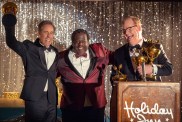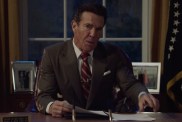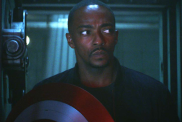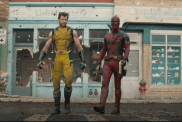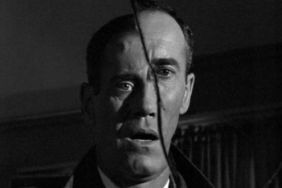At this year’s Fantasia Fest, we got to see Alexandre O. Philippe’s brilliant documentary 78/52, which is a feature-length dissection of the iconic shower scene with Janet Leigh in Alfred Hitchcock’s 1960 classic Psycho. Featuring interviews with Peter Bogdanovich, Guillermo del Toro, Jamie Lee Curtis, Bret Easton Ellis, Danny Elfman, Eli Roth and many others, it breaks down not only the meaning of the scene but the grueling planning that went into the seven days it took to shoot the minute-long sequence. In honor of 78/52, we thought we’d count down The 12 Best Hitchcock Movie Kills… besides the shower scene in Psycho. Check out our countdown in the gallery below! (Needless to say, BEWARE OF SPOILERS!)
This also seemed like a good time to do this list given that Hitchcock’s birthday was this past weekend on August 13, his 118th if he was alive. The director has been having several of his movies re-issued on Blu-ray, with Kino Lorber issuing a terrific new edition of Lifeboat (one of the movies on our list!) and the Criterion Collection issuing Hitchcock’s early silent serial killer masterpiece The Lodger: A Story of the London Fog, as well as a new collector’s edition of Rebecca coming on September 5.
Click here to purchase Lifeboat on Kino Lorber Blu-ray!
Click here to order Criterion’s The Lodger, and click here to pre-order Rebecca!
What is your favorite Hitchcock movie kill? Let us know in the comments below!
The 12 Best Hitchcock Movie Kills
-
#12: Lifeboat (1944)

Hitch's World War II-era film finds a group of survivors of a U-boat attack on a lifeboat struggling to coexist. During the film they discover the German Willi (Walter Slezak) has been hoarding water and drowned Gus (William Bendix), so they do what any sane, rational group does with a Nazi: They beat him senseless and throw him overboard to drown. Because that's what you do with murdering Nazis!
-
#11: Topaz (1969)

One of Hitchcock's least successful films is this tedious spy epic that feels like 2+ hours of outtakes from one of his better movies. It does contain one gorgeous shot of Cuban official Rico Parra (John Vernon) murdering his lover Juanita (Karin Dor) after discovering she has betrayed her country. It's a stunning overhead shot as she collapses, her purple dress contrasting with the black and white checkered floor pattern.
-
#10: North by Northwest (1959)

The Hitchcock trope of an innocent man framed for a murder he didn't commit reaches new heights in this scene where Cary Grant is meeting Townsend (Philip Ober) and evil henchman Leonard (Martin Landau) throws a knife into Townsend's back. Grant instinctually grabs the knife, thus making it look like he did the deed.
-
#9: Spellbound (1945)

While skiing John Ballantyne (Gregory Peck) has a breakthrough, remembering a key piece of childhood trauma: Sliding down a hand rail and accidentally knocking his brother onto a pointy fence, killing him. It's a shocking moment in an often surreal movie drenched in mid-20th-century pop psychology.
-
#8: Shadow of a Doubt (1943)

In this climactic scene, Uncle Charlie (Joseph Cotton) restrains his niece Charlie (Teresa Wright) onboard a moving train with the intent to push her out, but he winds up falling out himself and being hit by a train coming in the other direction. Ironic!!!
-
#7: Psycho (1960)

The shower scene is not the only great kill in Psycho. Later in the film private investigator Milton Arbogast (Martin Balsam) goes to the Bates home to interrogate Norman's mother, only to encounter Norman in a wig at the top of a staircase, who slashes him with a knife and sends him careening down the stairs to his death. The scene is especially effective because it's not a jump scare, you see Norman open the door and come for Arbogast from a God's eye view.
-
#6: Dial M for Murder (1954)

Shot in 3D (but mostly scene in 2D), this kill involves Swann (Anthony Dawson) attempting to strangle Margot (Grace Kelly) with a scarf, but she grabs a pair of scissors and stabs her attacker in the back. It's a very effective scene that would have been even cooler to see in 3D.
-
#5: Saboteur (1942)

The climax of this spy thriller features Kane (Robert Cummings) pursues the German saboteur Fry (Norman Lloyd) at the top of the Statue of Liberty, which eventually leads to Fry losing his grip and falling in a dramatic death loaded with symbolism. Again, that's what happens to Nazis.
-
#4: Rope (1948)

To have the opening shot of your film be a man getting strangled to death is the kind of gutsy showmanship only Hitch could deliver. The fact that it's two Harvard eggheads committing the murder of their classmate as an intellectual exorcise makes it doubly fascinating.
-
#3: Torn Curtain (1966)

Killing a man is HARD. That's the conceit of the brilliant German farm house scene, where Paul Newman and a farmer's wife (Carolyn Conwell) kill an East German security officer (Wolfgang Kieling) over an agonizingly long scene where he is strangled, stabbed and ultimately shoved in an oven, all while trying to keep it quiet.
-
#2: The Birds (1963)

This is a case of seeing only the aftermath of a kill being more effective than seeing the act itself, as Lydia (Jessica Tandy) discovers her neighbor pecked to death, his eyes gouged out horrifically. The scene is even more effective given there is no music in the scene.
-
#1: Vertigo (1958)

The ending where Judy (Kim Novak) falls out of the same bell tower where she faked her death at the beginning of the film leaves Jimmy Stewart's character devastated and most likely psychologically destroyed.


